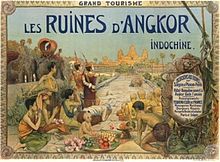George Groslier
George Groslier (born February 4, 1887 in Phnom Penh , Cambodia , † June 18, 1945 in Cambodia) was a French painter, museum director, archaeologist and art historian for the art of Southeast Asia, especially in Cambodia.
Life
Groslier was the son of a French civil servant in Indochina. He studied painting at the École des Beaux-Arts in Paris and, disappointed that he was only second in the competition for the Prix de Rome, went back to Indochina in 1911, where he discovered the temples of the Khmer , especially Angkor Wat . He tried to make this legacy known in numerous publications in France, and in 1913/14 received the order for a mission in Cambodia to explore the temples in Angkor from the French Ministry of Education and the Société asiatique. There, with the support of the Governor General in Hanoi Albert Sarraut (1917) and the Cambodian King Sisowath I, he organized arts and crafts schools and initiatives. He also organized the Cambodia Pavilion at the 1925 Arts and Crafts Exhibition and the 1931 Colonial Exhibition in Paris. He was also involved in the establishment of art schools in Hanoi. He was general inspector for art in Indochina and chief curator at the later National Museum in Phnom Penh (then Museum Albert Sarraut). In 1942 he retired and participated in the resistance against the Japanese occupiers as a radio operator. He was captured by the Japanese and died under torture.
He also wrote novels and about dance in Cambodia. In a book about it in 1913 he complained that due to the influence of Western culture even the king, noblewoman and the dancers themselves no longer knew the meaning of the individual gestures, which also applies to art and architecture. That was also the tenor in a report on culture in Cambodia for Albert Sarraut in 1917. He then tried very hard to revive traditional handicrafts and other traditions in Cambodia and Southeast Asia, which he saw in a state of or in danger of decadence.
His son Bernard Philippe Groslier was also a noted expert on the art of Southeast Asia.
Fonts
- Angkor. H. Laurens, Paris 1923.
- A l'ombre d'Angkor: notes et impressions sur les temples inconnus de l'ancien Cambodge. A. Challamel, Paris 1916.
- Danseuses cambodgiennes, anciennes & modern. A. Challamel, Paris 1913.
- Recherches sur les Cambodgiens d'aprés les textes et les monuments depuis les premiers siècles de notre ére. A. Challamel, Paris 1921.
- Les collections khmères du Musée Albert Sarraut à Phnom-Penh. G. van Oest, Paris 1931.
- La sculpture khmère ancienne. G. Crès, Paris 1925.
- La route du plus fort. Novel. Ed. Kailash, Paris 1994. (first 1926)
- Le retour à l'argile. Novel. Ed. Kailash, 1994. (first 1929)
- The art of the Cambodian dancer. Atlantis, January / March 1929.
- Eaux et Lumières. Journal de route sur le Mékong cambodia. 1931. (new edition 2008)
literature
- Gabrielle Abbe: La rénovation des arts cambodgiens George Groslier et le Service des arts, 1917–1945. In: Bulletin de l'Institut Pierre Renouvin. No. 27, 2008, pp. 61-76.
Web links
Individual evidence
- ↑ This was criticized in relation to the dance by Paul Cravath (* 1944), author of Earth in flower: the divine mystery of the Cambodian dance drama (2007), who pointed out that the royal dance pavilion had just opened in 1914
| personal data | |
|---|---|
| SURNAME | Groslier, George |
| BRIEF DESCRIPTION | French art historian |
| DATE OF BIRTH | February 4, 1887 |
| PLACE OF BIRTH | Cambodia |
| DATE OF DEATH | June 18, 1945 |
| Place of death | Cambodia |
